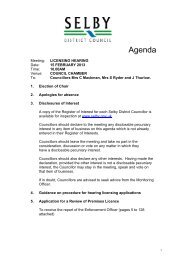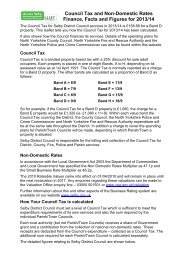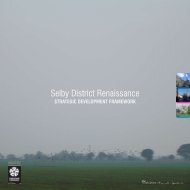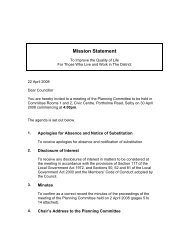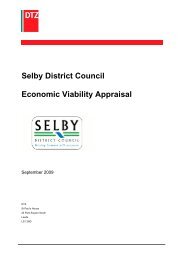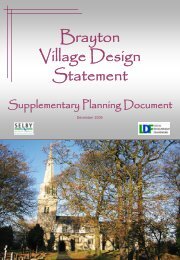Yorkshire's First Railway Station A commemorative booklet
Yorkshire's First Railway Station A commemorative booklet
Yorkshire's First Railway Station A commemorative booklet
Create successful ePaper yourself
Turn your PDF publications into a flip-book with our unique Google optimized e-Paper software.
Yorkshire’s <strong>First</strong> <strong>Railway</strong> <strong>Station</strong><br />
A <strong>commemorative</strong> <strong>booklet</strong><br />
Marking the 175 th anniversary<br />
of the opening of Selby station. 1<br />
22 nd September 1834.
Why a Rail Road?<br />
West Yorkshire wool and coal traders of the 1820s had a problem.<br />
Turnpike roads were a mass of mud.<br />
It could take a week to get wool from the West Riding to the coast.<br />
The waterways were no better either.<br />
Tides on the river were unpredictable – one week floods, the next<br />
ships are stuck on the shallows.<br />
To use the Aire and Calder canal was expensive and the Selby Canal<br />
was too small. In 1826, a new canal link was made to Ferrybridge, and<br />
the port of Goole was being developed, but basically, transport of<br />
goods was in the hands of monopolies who could charge what they<br />
wanted.<br />
So, this was the situation:<br />
Leeds was the capital of the clothing industry, and trade with Europe<br />
was increasing, but access to East Coast ports was unsatisfactory.<br />
The problem was not only with cloth merchants. Coal mine owners<br />
such as the Gott and Gascoigne families in and around Garforth had<br />
valuable materials to transport. Industry needed cheap coal. Journeys<br />
by canal could involve ten or more transfers between barges, which<br />
pushed up price and reduced quality.<br />
Wealthy landlords had agricultural produce to transfer, and quarry<br />
owners needed to get their stone to market. Many quarries were miles<br />
from the nearest canal, adding to the problem.<br />
The Miners’ Arms<br />
Two pubs, 2 still trading in Garforth, remind us why the Leeds and Selby was<br />
built. Miners hewed coal for industrialists such as the Gascoigne family.
All in all, there was a pent-up demand for an efficient way to<br />
move a vast range of produce. Liverpool and Manchester had a new<br />
railway, meaning the Lancastrians could transport their goods quicker<br />
and cheaper. A trade War of the Roses was brewing and Yorkshire<br />
needed a rail road to make the fight fair. The rail road would release<br />
all the pressure – eventually.<br />
The coming of the Rail Road<br />
Many efforts had been made to improve communications between<br />
Leeds and Selby. A canal link had been surveyed in 1769, and the<br />
Selby Canal between Selby and Haddlesey was opened in 1778, which<br />
solved some problems. The journey by river and canal was 30 miles as<br />
opposed to 20 by road, but the waterway was much more reliable.<br />
When the Aire and Calder canal opened to Goole in 1826, trade<br />
slipped away from Selby. Something had to be done!<br />
In 1821, a rail road had been suggested, and famous engineer George<br />
Stephenson surveyed a route in 1825. However this used the old<br />
technology of horses and ropes. The success of the Middleton <strong>Railway</strong><br />
in Leeds showed steam engines were the way forward.<br />
James Walker was asked to survey a route. In 1829 his report was<br />
published. It had an astonishing proposal. The railway would have a<br />
half-mile tunnel, and steam engines would pull loads through it!<br />
The route was just over 19 miles long and<br />
was to end in a “commodious station at Selby”<br />
with six platforms, two for passengers and<br />
the rest for goods. Goods were always more<br />
important than passengers.<br />
Selby<br />
Old <strong>Station</strong><br />
Sept. 2009<br />
Inside Selby Old<br />
station c 1950s.<br />
Courtesy R. Moody<br />
Passengers and goods had to cross<br />
Ousegate for packet boats to travel to<br />
Hull or York. So, to some extent<br />
3<br />
early train times depended<br />
on tides on the River Ouse.
Construction of the line<br />
Engineering in the 1830’s was done by hand. The men who did it<br />
were ‘navvies’, short for ‘navigators’, harking back to the days of<br />
canal building.<br />
The navvies had to be tough. They were expected to swing a pick and<br />
shovel and to barrow rock and soil for ten hours a day. In this time, a<br />
good navvy would shift 15 tons. Life and limb was risked in blasting<br />
tunnels and building bridges.<br />
Plenty of food was available for those who signed up. Four pounds of<br />
beef and a gallon of ale a day was a typical navvies’ diet.<br />
Navvies worked hard and they drank hard. "Going on a Randy" was<br />
slang for going on a drinking spree that could last several days.<br />
Hangovers halted track laying, and harvest time offered easier work<br />
in the fields, so progress was also slower in August.<br />
Living conditions were awful. Navvies lived in shanty towns, in huts<br />
beside the route. Eight men to a hut, with eight sets of clothes to dry<br />
after a day’s sweat and mud. No wonder they said “The best you’ll<br />
ever be is damp”.<br />
Pay was monthly – but everything came through the company store,<br />
so the navvies never saw cash – just a credit bill at the Tommy, or<br />
company, shop. The company always seemed to see to it that you<br />
were owing at the end of the month – so you’d always have to work<br />
another month to catch up. Of course there was an endless supply of<br />
beer.<br />
It took around three years to build the 19-mile long line, including the<br />
famous tunnel. Most of the line was built at a fairly gentle gradient of<br />
1 in 137, but this was only achieved by creating 6 miles of cuttings<br />
and embankments, 4<br />
by barrowing soil and rock from one part of the<br />
line to another.
Richmond Hill, on the outskirts of Leeds was too high for a cutting, so<br />
a tunnel was needed. As designed by James Walker it was almost half a<br />
mile long.<br />
Rock had to be blasted out using gunpowder, as dynamite had yet to<br />
be invented. Just like bonfire night, the fuse would often go out – but if<br />
you went back to check and the fuse blew, you’d be buried under tons<br />
of rock. Many men lost their lives. In 1832, the driving of the line was<br />
more important than health and safety.<br />
The tunnel was a thing of wonder to people in 1834, and many thought<br />
the darkness impenetrable. The Mechanics Magazine of 1835 describes<br />
the horrid experience:<br />
…As we entered the tunnel…. ”We were immediately enveloped in total<br />
darkness and every one of the coaches filled with smoke to a most annoying<br />
degree. Though we were but a few minutes going through such was the<br />
nuisance that we thought it was an hour”<br />
The railway company painted the inside of the tunnel with whitewash<br />
and used copper reflectors to try to relieve the gloom.<br />
The tunnel was widened and shortened in 1894.<br />
The effect on passengers of going through the tunnel was described in<br />
Parson’s “A Traveller’s companion” of 1835.<br />
“The change produced by transit through this tunnel is extraordinary, and as<br />
pleasing as it is extraordinary. The traveller leaves behind him a region where<br />
the smoke of countless factories pollutes the atmosphere…He enters upon a<br />
scene where no such contamination affects his organs, where the whole<br />
population is agricultural and where rural tranquillity and peace are never<br />
invaded and destroyed”<br />
Nowadays this is the area of Neville Hill depot.<br />
5
A 2009 Transpennine Express train passing under the 1830s<br />
“Wonder of the new industrial age” at Garforth<br />
Beyond Richmond Hill, the major structures were stone bridges. An<br />
arch bridge crosses what is now Selby Road, and was described in<br />
1834 as “an astonishing display of industry and art”, and a further angled<br />
bridge at Garforth was proclaimed “a wonder of the new industrial age”.<br />
The building of the line attracted foreign visitors too, and the cuttings<br />
around Micklefield <strong>Station</strong> were described by a French engineer as<br />
“superior to any other I have seen in England”.<br />
After Micklefield, the terrain was a good deal gentler and construction<br />
of the line into Selby that much easier to accomplish.<br />
However, the line did suffer subsidence as it crossed old mine<br />
workings, a problem that returned with the Selby coal field in 1984.<br />
Once the line was complete, canal owners reduced their charges in a<br />
vain effort to regain goods traffic.<br />
6
The first train arrives<br />
The 22 nd of September 1834 was seen as a very important day indeed. A<br />
few trial runs had been carried out prior to this over part of the line, but<br />
this was the day for the first complete run. The date was also chosen to<br />
allow music fans to attend a festival in Hull.<br />
The engine ‘Nelson’ was attached to nine carriages, containing 156<br />
passengers. Three of the carriages were painted yellow and were<br />
enclosed, like stage coaches. They were called “Juno”, “Diana” and<br />
“Vesta”. These were for first class passengers. The other six were open<br />
to the air. Nowadays we would call them cattle trucks!<br />
This adaptation of the “Leeds Mercury” story tells the day’s events<br />
“At first the journey was extremely slow. The first two miles took 40 minutes<br />
to be covered. Spectators began to jest and ridicule,. Merry derision came from<br />
the crowd…some passengers got off and pretended to push the carriages. After<br />
an hour and three quarters, “Nelson” came to a halt, having covered just 4<br />
miles.<br />
One of the trucks was removed, and “Nelson” tried again, to much better<br />
effect.<br />
Garforth was reached comfortably, but a stop had to be made for water. Five<br />
minutes later, off again down the slope to Selby. Speeds as rapid as 20 mph<br />
were reached. The final 16 miles were covered in just over the hour.<br />
Arrival in Selby was in perfect safety just before 9 am. A great number of<br />
persons greeted the train with loud cheers and a small cannon was fired. Those<br />
who wished could catch the boat for Hull.<br />
Nelson had some running repairs and left for Leeds at 11:10. The journey back<br />
was achieved in just over the hour, averaging 16mph and the train was<br />
welcomed back to Leeds by a crowd in excess of 30000.<br />
The conclusion was<br />
‘The day was beautiful, passengers were delighted and the whole affair 7<br />
resounded to the credit of the company”
Journeys in the early days<br />
Once the service had settled down, trains regularly left Leeds for<br />
Selby at 6am to connect with packet boats for Hull and York. Stage<br />
coaches and packet boats altered their timings to meet up with the<br />
train.<br />
For instance, a carriage ran from Kirkgate to catch the train at Marsh<br />
Lane in Leeds.<br />
The 5 am “<strong>Railway</strong>” stagecoach from Knaresborough had seven<br />
calling points before making the connection at Micklefield.<br />
Travellers were tough back then! A cheap single from Knaresboro’ to<br />
Hull was 6/6 (33p).<br />
The return was early in the afternoon. Journey time was around 75<br />
minutes.<br />
In the first week of operation, about 1500 passengers were carried.<br />
After a year or so, this had increased to 3500 passengers a week which<br />
is ten times the number of people who had used the coach on the<br />
roads.<br />
Prices paid depended on how far you went. Up to five miles, it was<br />
sixpence (2.5p). Between 5 and 10 miles was a shilling (5p). The Leeds<br />
to Selby trip, second class, was 2 shillings (10p). It was an extra<br />
shilling for the boat to Hull. For comparison, an agricultural workers<br />
wage was about 10/- (50p) per week.<br />
Tickets were purchased in the Superintendent’s house next to the<br />
railway station.<br />
<strong>Station</strong>s were at Hambleton, Milford, Micklefield, Garforth and Cross<br />
Gates. The journey ended at Marsh Lane – about a mile short of the<br />
current<br />
8<br />
Leeds terminus.<br />
In the first year, 100913 passengers were carried, paying £11947.
Early problems<br />
There were complaints and concerns about the new mechanical<br />
monsters. To fight these criticisms, the Act of Parliament that<br />
authorized the line stated “The furnaces of every steam engine…every<br />
locomotive or movable engine will be constructed on such a principal as to<br />
consume its own smoke…” Amazingly, MPs believed smoke-eating was<br />
possible, and passed the Act.<br />
Noise pollution problems also existed. Early reports suggest that the<br />
first locos made “sounds like the groans of a large elephant”<br />
Elephantine or not, the passage of the trains was such to cause<br />
commotion in animals. In 1857 the “Yorkshire Gazette” reports an<br />
unfortunate Mr Wood from Drax was driving his gig when the horse<br />
was alarmed at the sight of the steam engine. It bolted towards the<br />
park wall. A passer-by had to leap over the wall to avoid being run<br />
down and Mr Wood and his startled passenger were ejected onto the<br />
street.<br />
A few years later, a similar mishap befell a Mr Holdsworth.<br />
Unfortunately his carriage contained a piano. As the horse bolted the<br />
unwilling pianist was dragged “a considerable distance” leaving him<br />
severely black and blue rather than ebony and ivory.<br />
Problems could also be caused by lack of locomotive power. Several<br />
reports exist of problems on the inclined parts of the line, however<br />
gentle the gradient. In one case, the train shuddered to a halt between<br />
Milford and Micklefield with “spurting and groaning noises coming from<br />
the engine”.<br />
Whilst today, we might groan, complain about the railways and wait<br />
for a replacement bus, travellers back then were more resilient.<br />
Gentlemen were asked “please leave your seats to lighten the loads” and to<br />
help push the train. This was done “with great alacrity” before jumping 9<br />
back aboard to coast into Leeds.
Onwards to Hull ?<br />
Mind you, whilst the trip from Leeds to Selby was now much smoother,<br />
it was still quite an adventure to get to Hull!<br />
The river journey was 43 miles, and the Ouse and Aire have many<br />
narrow bends, areas of shallow water and tricky tides.<br />
A report of 1835 in Head’s “Home Tours” described the antics that<br />
passengers had to undergo.<br />
“Whenever, in a course, gruff voice, the Captain ordered ’Rowl her’ the crowd,<br />
like sheep at the barking of a dog, walked across the deck, treading on one<br />
another’s heels, with much inconvenience.<br />
At the same time they hailed a rope, previously sent on shore, and made it fast<br />
to a post or a tree until the vessel disengaged from her soft bed. It could then<br />
float again in the river channel”<br />
An average trip took around 4 hours. Despite this, by 1838, the Leeds<br />
and Selby railway was advertising one of the first rail excursions in the<br />
world “To Hull and back – in a day!”<br />
These river voyages couldn’t last. Rail was far more efficient, so it was<br />
no surprise when the railway was extended to Hull in July 1840. Selby<br />
became just a half-way halt on the railway between Leeds and Hull. A<br />
new swing 10 bridge was opened over the river, and the current<br />
passenger station was built.
The end of the independent Leeds to Selby line<br />
Just three months later, the Leeds to Selby was involved in railway<br />
politics. George Hudson, the York-based ‘<strong>Railway</strong> King’ negotiated a<br />
lease on the line. This cost him £17000 per year. He soon got this back<br />
however, as no sooner had he got the lease than he shut the line to<br />
passengers in November 1840! The idea was to force everyone to use<br />
the lines that Hudson owned, to maximize his profits.<br />
By 1841, the original station had its passenger entrances onto Ousegate<br />
bricked up. There is still a lintel in place on the exterior wall showing<br />
this date. This did not mean that the old station had no further use.<br />
Indeed it became a goods warehouse, and was well used to store the<br />
huge volume of goods that still travelled through Selby by rail, river,<br />
canal and road.<br />
But Hudson had other ideas. He purchased the line outright in 1844.<br />
Goods still used the services, but Hudson then put a stop to that when<br />
he closed the line completely in July 1848!<br />
The situation was only resolved when Hudson went bust in 1850.<br />
Freight and then passenger services were reintroduced over the line in<br />
the course of the next 4 months.<br />
After this turbulent start, the Leeds to Selby line settled down to a quiet<br />
existence. The York and North Midland <strong>Railway</strong>, which was Hudson’s<br />
company, became part of the North Eastern <strong>Railway</strong> in 1854. This then<br />
became part of the London and North Eastern <strong>Railway</strong> in 1923, then<br />
British <strong>Railway</strong>s in 1948.<br />
Following privatization, the line’s franchise is worked by Northern<br />
Rail, and TransPennine Express. Hull Trains also use the line as an<br />
Open Access operator.<br />
The frequency and speed of services along the line greatly exceed<br />
James Walker’s original plans, but he might be intrigued by how 11 little<br />
freight now passes between Leeds and Selby by rail.
A modern journey from Leeds to Selby<br />
Today’s journey starts at the main Leeds station, built in 1869. Pass<br />
the Parish Church on the right on an embankment paved with<br />
gravestones. Church authorities insisted on this ostensibly to avoid<br />
disturbing graves.<br />
As the cement terminal is passed on the left, so the train also passes<br />
the Marsh Lane site of the original station for the Leeds to Selby line.<br />
This closed in 1958, but George Hudson’s actions over a century<br />
before had greatly reduced its importance by concentrating all<br />
services on stations in central Leeds.<br />
Crossing over the skew bridge referred to in glowing terms in 1834,<br />
Cross Gates station is reached. Beyond this station was Vickers<br />
armaments factory, once “Barnbows Plant”, closed in the 1990s.<br />
The train is now approaching Garforth, and the area that was full of<br />
the coal mines whose produce was a vital factor in the planning and<br />
building of the line. Garforth station is little changed and is typical of<br />
the mid 19 th century station buildings of the North Eastern <strong>Railway</strong>,<br />
with pointed roofs, a veranda and gable ends facing the platform.<br />
12<br />
Garforth <strong>Station</strong> 2009
Travelling past Garforth, as the line eases left, modern factory units<br />
mark where the branch to Kippax and Castleford – and more coal –<br />
branched off on the right, until the 1980s.<br />
Whilst that line has been abandoned as freight lost importance, a sign<br />
that passengers became more significant is East Garforth station,<br />
opened in May 1987. The contrast with Garforth could hardly be more<br />
marked, as the newcomer has the bare minimum in terms of shelters<br />
and platforms, but it fulfils a vital role for hundreds of commuters.<br />
More former coal fields are on the right. The train then passes under<br />
the A656, and past a little – used industrial estate on the site of<br />
Peckfield Colliery. History is not static and whilst Micklefield is now<br />
just a commuter halt, exciting plans exist for the future of the Leeds to<br />
Selby line here. These include a new “turnback” facility to increase<br />
peak capacity to and from Leeds, a park and ride station called East<br />
Leeds Parkway, where long distance services may call, a fifth<br />
TransPennine Express each hour and electrification to Selby.<br />
The 1834 arch bridge at Micklefield<br />
Whatever the provision, the rails still run<br />
on a fine 1834 bridge over the Great North<br />
Road. Here, the 5am coach from<br />
Knaresboro’ deposited its weary<br />
passengers. Goods came to the station by<br />
this route, and were lifted up to the line<br />
from a rail building on the road below.<br />
Just beyond the platform end<br />
at Micklefield, the line to York<br />
leaves to the left, but the Selby<br />
train forges straight ahead, passing<br />
under the new Great North Road,<br />
the A1(M). The cuttings are those<br />
which attracted the French<br />
enthusiasm, mentioned earlier.<br />
“A marvellous cutting”<br />
13
South Milford<br />
2009 2009<br />
Moving beyond West<br />
Yorkshire, the next station is<br />
South Milford. Again, all<br />
trace of 19 th century building<br />
has gone, and two platforms<br />
and simple shelters are all<br />
that are present.<br />
The line in this area is mainly level, and the locomotives of the 1830s<br />
would have accelerated to around 20 mph on these stretches. Beyond<br />
Milford, the line passes over what was Hudson’s York and North<br />
Midlands <strong>Railway</strong> scene of much controversy over the years.<br />
Here, Hudson’s control closed the Leeds to Selby.<br />
Just beyond is Gascoigne Wood. In the early 1900s,<br />
migrants travelled between Hull and Liverpool as<br />
part of their journey from Russia to the USA. Their<br />
trains had no toilets, so the station here acted as a<br />
welcome “relief stop”! Gascoigne Wood goods<br />
yard also dealt with Selby coalfield’s output,<br />
closing in 2004. The derelict site was proposed as a<br />
location for West Yorkshire’s “eco town”.<br />
Gascoigne Wood<br />
Signal box 2009<br />
The line then crosses the newest stretch of East Coast Main Line, at<br />
the site of Hambleton <strong>Station</strong>, closed in 1959. The new ECML opened<br />
in 1983 to avoid possible subsidence from Selby coalfield workings,<br />
and speed restrictions on severe curves north of Selby.<br />
The level crossing on the A63 is at Thorpe Willoughby. Selby Canal is<br />
to the right, over which a line went to Goole until the 1950s.<br />
The train now winds slowly round sharp corners to enter Selby. The<br />
original station is beyond the current running lines. From Platform 3,<br />
the white gable ends of the original station are visible, with the Viking<br />
Shipping 14 Services logo. Six tracks ran in, four for freight, two for<br />
passengers. All links were removed in the 1980s.
What is visible of the 1834 station today?<br />
The running lines and old station building are now private property<br />
and part of the busy working environment of Viking Shipping. There is<br />
therefore no public access. To see how the lines went into the station,<br />
go onto the road overbridge and look back towards the station. The<br />
triangular pediments mark the top of the train sheds, with modern<br />
buildings on what were the goods areas in front.<br />
Much of the station’s exterior can be investigated from Ousegate.<br />
Turn right out of the station, right at the end and under the current<br />
lines. On your right is the station master’s house, with rail-inspired air<br />
bricks. This is where tickets were purchased. Beyond that are the<br />
massive blue doors that would open for access to the rail-transported<br />
goods. Take a few seconds to marvel at the massive timbers, mighty<br />
wheels, handles and pulleys that are still in place. High on the central<br />
wall is the 1841 lintel marking the development of the new station.<br />
In 1834, if you wished to continue your journey, you would now have<br />
to cross Ousegate to one of the staithes or jetties.<br />
These are still in place today, but rapidly becoming derelict, and are<br />
not available for public inspection. On the town side of the rail bridge<br />
one of the jetties still has a gate post and pulley that seem to show rail<br />
ancestry.<br />
However, you can still see how passengers would have embarked onto<br />
those packet boats. Walk up Ousegate, cross the river at the road<br />
bridge and walk back on the far bank.<br />
15
Just before the current rail bridge, look over the flood wall. A cinder<br />
track shows the line of the original Selby to Hull 1840 extension. Go<br />
under the rail bridge and look across the river through the rampant<br />
vegetation and you will see the remnants of a jetty and a ladder that<br />
could once have been used. This is all that remains of the<br />
embarkation points for boats to Hull or York.<br />
Roof of train shed<br />
Decaying jetty<br />
With that view the investigation of Yorkshire’s first main line is<br />
complete. In 1834, the “Leeds Times” described the arrival of the first<br />
train in these words: “A great number of respectably attired persons …<br />
loudly cheered the passengers and gave a hearty and exulting welcome to…<br />
this delightful, improving and hospitable town”.<br />
Whilst the cannon fire that greeted the first arrival is unlikely to be<br />
repeated, do take some time now to enjoy the delights of what still is a<br />
“delightful, improving and hospitable town”.<br />
SELBY CIVIC SOCIETY<br />
References<br />
Terry Coleman : “The <strong>Railway</strong> Navvies”<br />
METRO : “Yorkshire’s first main line” and quotations therein.<br />
Edward Parsons 16 : “The Traveller’s Companion”<br />
Patricia Scott : “The History of Selby”, and quotations therein<br />
W.W. Tomlinson : “History of the North Eastern <strong>Railway</strong>”<br />
Researched and published by Groundwork North Yorkshire September 2009. groundwork-northyorkshire.org.uk



